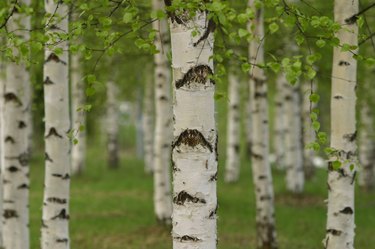
Alder (Alnus spp.) and birch (Betula spp.) are native North American trees, typically found grown along rivers and streams. They are also useful as landscape specimens for gardeners in U.S. Department of Agriculture zones 2 through 11 and 2 through 9a for alder and birch, respectively. These are equally appealing choices for moist, semi-shady areas of the landscape -- the choice of which to plant may come more from choosing an appropriate variety from the dozens that exist among the species.
Appearance
Video of the Day
The leaves of birches and alders are very similar, frequently leading to confusion between the species. Both are serrated and oval-shaped, about 2 to 3 inches wide by 3 to 4 inches long. Birch leaves have a pointed tip, and some varieties are spade-shaped, while alders are generally more rounded in appearance. Depending on the variety, both trees may have smooth silver or white bark, although birches are particularly known for this trait. Most birches and alders grow much taller than wide, and all varieties have showy male "catkins" that release their pollen in spring and are followed by small cone-like fruits that hang gracefully on the branches over a long period.
Video of the Day
Culture
These are moisture-loving trees and grow well in deep, fertile soils that are rich in organic matter. Of the two, alder is more tolerant of poor soil quality and has a unique biological adaptation to produce its own nitrogen in the soil. Birches and alders have extensive, mat-forming root systems that suck up any available moisture but can also make them difficult to garden under. They will tolerate full sun, but most types of both species are at home in partial shade.
Problems
In general, birches are more prone to pests and disease than alder. The bronze birch borer is a significant problem for many birch species, and resistant varieties are now recommended for planting in areas where this pest is common. Birches are also highly susceptible to infestations of aphids and black mildew. These often occur simultaneously and result in a sticky black substance coating the surface of anything under the trees -- a nuisance for homeowners who have planted them over patios or parking areas. Some alder species are also susceptible to borers, and several fungal and bacterial diseases are common to both species, but as a whole, alders show greater resilience in landscape plantings.
Varieties
For a white-barked birch that is resistant to borers, "Heritage" River Birch (Betula nigra) is the best choice. Hardy in USDA zones 4a through 9a, the tree is adapted throughout most of the country and shows high resistance to other pests and disease of birches, as well. Red Alder (Alnus rubra) is the variety of alder that is most similar to the white-barked birches. The bark starts out gray, becoming increasingly white with age, and has a peeling, flaky texture. Red Alder is native to the West Coast and can be grown in USDA zones 5 to 8.
- University of Maine Cooperative Extension: Hazel Alder or Speckled Alder
- University of Florida IFAS Extension: White Alder
- University of Illinois Extension: European Alder
- University of Florida IFAS Extension: "Heritage" River Birch
- NC State University Consumer Horticulture: Paper Birch
- WSU Clark County Extension: Red Alder